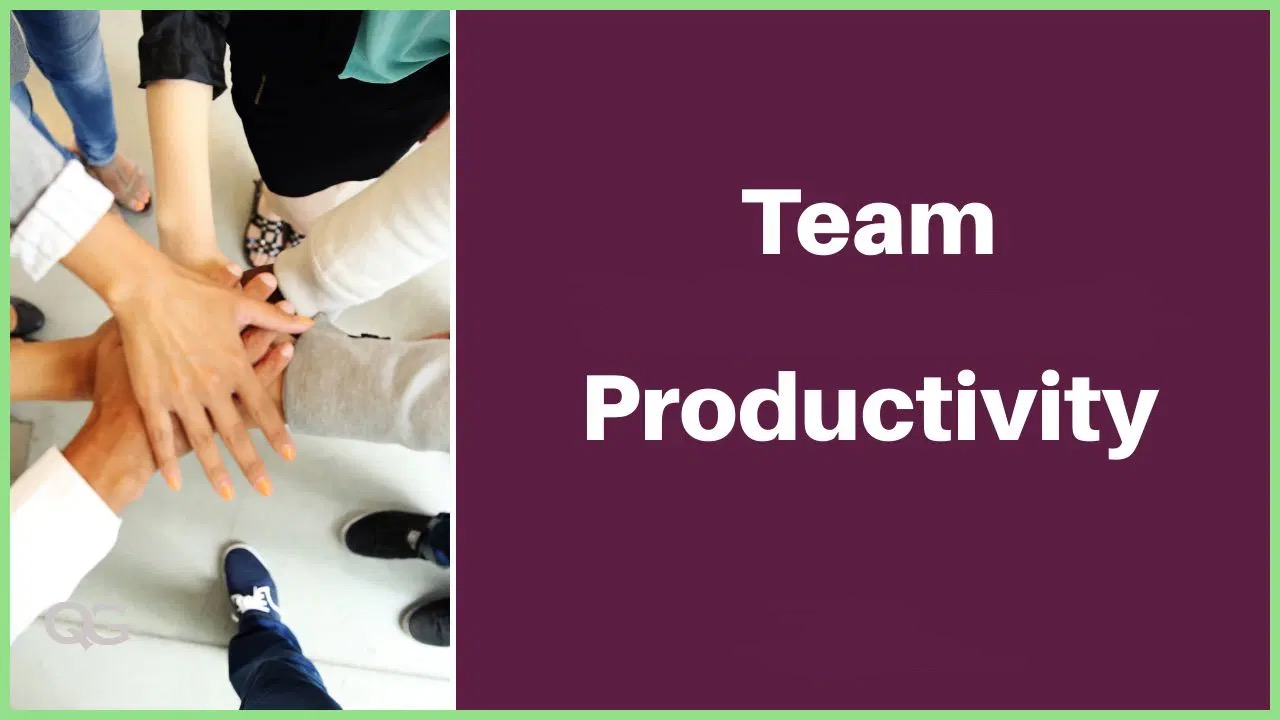The Ultimate Guide to Team Productivity: Strategies, Tools, and Implementation

Loading...

Team productivity stands as the cornerstone of organizational success, directly influencing business outcomes, employee satisfaction, and competitive advantage. In today's fast-paced business environment, understanding how to enhance team productivity has become more crucial than ever. This comprehensive guide provides managers, team leads, and business owners with proven strategies, essential tools, and practical implementation techniques to transform team productivity and achieve exceptional results.
Effective team productivity isn't merely about completing more tasks—it encompasses achieving goals efficiently, maintaining high quality standards, and ensuring sustainable performance. Organizations that master team productivity experience improved business outcomes, increased employee satisfaction, reduced operational costs, and enhanced innovation capabilities. The principles of team productivity extend across all organizational levels, from frontline teams to executive leadership.

Team productivity represents the collective efficiency and effectiveness with which groups accomplish their objectives while maintaining quality standards and sustainable practices. This fundamental concept encompasses multiple dimensions including output quality, goal achievement speed, resource utilization efficiency, and team member satisfaction. Team productivity measurement provides critical insights into group dynamics, process effectiveness, and opportunities for continuous improvement.
The significance of team productivity extends beyond simple task completion metrics to include collaborative effectiveness, innovation capacity, and adaptability to changing circumstances. High-performing teams with excellent team productivity demonstrate superior problem-solving abilities, enhanced communication patterns, and stronger resilience during challenging periods. These teams create synergistic effects where collective output exceeds the sum of individual contributions.
Modern team productivity relies on several interconnected elements that work together to create optimal performance conditions. Clear goal alignment ensures all team members understand objectives, priorities, and success metrics for effective team productivity. Psychological safety provides the foundation for open communication, risk-taking, and learning from mistakes that enhance team productivity. Trust and transparency foster collaborative relationships that enhance team productivity through improved information sharing and mutual support.
Effective leadership plays a crucial role in team productivity by providing direction, removing obstacles, and creating environments where teams can thrive. Leaders who understand team productivity principles balance autonomy with accountability, encourage innovation while maintaining focus, and provide resources necessary for team productivity success. This leadership approach creates cultures of high performance that sustain team productivity over time and maximize team productivity potential.

Exceptional team productivity builds upon five fundamental pillars that create comprehensive frameworks for sustained high team productivity performance. These pillars provide structured approaches to enhancing team productivity while ensuring long-term team productivity sustainability and continuous improvement.
Establishing clear vision and goal alignment forms the foundation of team productivity by ensuring all members work toward common objectives. SMART goals (Specific, Measurable, Achievable, Relevant, Time-bound) provide clarity and direction that enhances team productivity through focused effort and coordinated action for optimal team productivity. OKRs (Objectives and Key Results) offer additional frameworks for aligning individual contributions with organizational priorities that support team productivity.
Goal cascade processes ensure team productivity objectives align with broader organizational strategies while maintaining relevance at the team productivity level. Regular goal review sessions help teams adjust priorities based on changing circumstances while maintaining momentum toward critical team productivity outcomes. This alignment creates clarity that eliminates confusion and enhances team productivity through coordinated effort.
Vision communication requires consistent messaging that helps team members understand how their contributions impact overall team productivity success. Leaders who effectively communicate vision create emotional connections that motivate teams and enhance team productivity through increased engagement. Clear vision statements provide decision-making frameworks that guide daily actions and priorities supporting team productivity.
Communication excellence directly impacts team productivity by determining how effectively information flows within groups and how efficiently decisions get made. Clear communication protocols reduce misunderstandings, accelerate problem-solving, and enable faster response to challenges. Teams with superior communication patterns demonstrate higher team productivity levels through reduced delays and improved coordination that supports team productivity.
Active listening skills enhance team productivity by ensuring accurate information transfer and demonstrating respect for diverse perspectives that support team productivity. Team members who practice active listening contribute to psychological safety while gathering comprehensive information for better decision-making that improves team productivity. This communication approach creates environments where team productivity flourishes through inclusive participation.
Structured feedback mechanisms support team productivity improvement by providing regular opportunities for course correction and skill development that enhances team productivity. Constructive feedback helps team members understand their impact on overall team productivity while identifying areas for professional growth that supports team productivity. Regular feedback loops create continuous improvement cycles that sustain high team productivity performance levels.
Modern collaboration tools significantly impact team productivity by enabling seamless teamwork across different locations and time zones for enhanced team productivity. Platforms like Microsoft Teams, Slack, and Asana facilitate real-time collaboration while maintaining project visibility and accountability that supports team productivity. These tools enhance team productivity by reducing communication delays, centralizing information, and streamlining coordination processes that optimize team productivity.

Workflow optimization represents a critical pillar of team productivity that focuses on eliminating inefficiencies, reducing waste, and streamlining operations for enhanced team productivity. Process mapping helps teams visualize current workflows while identifying bottlenecks that limit team productivity and impact overall team productivity. Regular process reviews enable continuous team productivity optimization that adapts to changing requirements while maintaining efficiency standards for team productivity.
Standard Operating Procedures (SOPs) enhance team productivity by providing consistent approaches to common tasks and reducing decision fatigue that impacts team productivity. Well-documented processes enable faster onboarding, reduce errors, and ensure quality consistency for improved team productivity. Teams with comprehensive SOPs typically demonstrate higher team productivity levels through reduced confusion and improved execution speed that maximizes team productivity.
Task prioritization frameworks like the Eisenhower Matrix help teams focus on high-impact activities that drive team productivity and maximize team productivity potential. Effective prioritization ensures limited resources concentrate on activities that generate maximum value while minimizing time spent on low-priority tasks that could affect team productivity. Priority management systems create focus that enhances overall team productivity through strategic resource allocation for optimal team productivity.
Meeting optimization significantly impacts team productivity by ensuring time spent in meetings generates proportional value for enhanced team productivity. Effective meetings have clear agendas, defined outcomes, and specific time limits that respect participants' schedules and support team productivity. Teams that implement structured meeting protocols typically report improved team productivity through better decision-making and reduced time waste that enhances overall team productivity.
Technology integration serves as a powerful catalyst for team productivity enhancement by automating routine tasks, improving accuracy, and enabling scalable operations. Strategic technology adoption involves selecting tools that align with team objectives and integrate seamlessly with existing workflows. Teams that successfully leverage technology for productivity gain significant advantages through enhanced efficiency and reduced manual effort.
Project management software plays a crucial role in modern team productivity strategies by providing visibility into task status, resource allocation, and timeline management. Tools like Asana, Trello, and Monday.com enable teams to collaborate more effectively while maintaining accountability and transparency. Organizations using these platforms typically report significant improvements in project completion rates and overall team productivity.
Time tracking and reporting tools provide insights into how teams allocate effort while identifying opportunities for team productivity improvement. These tools help teams understand where time gets spent and which activities generate the most value. Data-driven insights enable more informed decisions about resource allocation and process optimization that enhance team productivity.
Document sharing and knowledge management systems centralize information access while reducing time spent searching for resources. Platforms like Google Drive, Notion, and SharePoint enable teams to maintain organized information repositories that support team productivity through improved accessibility and collaboration capabilities.
Culture and engagement optimization creates environments where team productivity can flourish through motivated, committed team members who feel valued and empowered. Psychological safety forms the foundation of productive team cultures by enabling open communication, creative thinking, and learning from mistakes. Teams with high psychological safety demonstrate superior team productivity through increased innovation and collaboration.
Recognition and reward systems enhance team productivity by acknowledging contributions and celebrating achievements. Regular recognition creates positive feedback loops that motivate continued high performance while reinforcing behaviors that support team productivity. Effective recognition programs balance individual achievements with team accomplishments.
Work-life balance initiatives support sustainable team productivity by preventing burnout and maintaining long-term performance capacity. Teams that prioritize balance demonstrate more consistent productivity levels while retaining talent more effectively. Sustainable approaches to team productivity consider both short-term performance and long-term team health.
Professional development opportunities enhance team productivity by ensuring team members possess current skills and knowledge required for optimal performance. Training investments pay dividends through improved capabilities, increased confidence, and enhanced job satisfaction. Teams with strong learning cultures consistently demonstrate higher productivity levels compared to those without development focus.

Successful team productivity implementation requires systematic approaches that address cultural transformation, process optimization, and technology integration. These practical strategies provide roadmaps for achieving sustainable team productivity improvements while maintaining quality standards and team satisfaction.
Trust building represents the foundation of high-performance team dynamics that enable exceptional team productivity. Trust development requires consistent actions, transparent communication, and demonstrated reliability over time. Teams with high trust levels collaborate more effectively, share information more freely, and support each other during challenging periods.
Conflict resolution skills enable teams to address disagreements constructively while maintaining team productivity and relationships. Healthy conflict resolution processes help teams navigate diverse perspectives while finding solutions that benefit overall objectives. Teams skilled in conflict management typically demonstrate higher productivity levels through reduced tension and improved collaboration.
Team formation processes impact long-term team productivity by establishing norms, expectations, and working relationships from the beginning. Intentional team formation includes role clarity, communication protocols, and shared agreements about collaboration approaches. Well-formed teams typically achieve higher productivity levels more quickly than those without structured formation processes.
Diversity and inclusion initiatives enhance team productivity by leveraging different perspectives, experiences, and skills. Inclusive teams demonstrate superior problem-solving abilities and innovation capacity through diverse thinking approaches. Teams that embrace diversity while maintaining inclusion typically achieve higher productivity levels than homogeneous groups.
Process documentation enhances team productivity by creating knowledge repositories that reduce dependency on individual team members. Comprehensive documentation enables faster problem resolution, easier knowledge transfer, and more consistent execution quality. Teams with well-documented processes typically demonstrate higher productivity levels through reduced confusion and improved efficiency.
Automation implementation strategies focus on identifying repetitive tasks that technology can handle more efficiently than humans. Effective automation frees team members to focus on higher-value activities while reducing errors and accelerating completion times. Teams that strategically implement automation typically achieve significant team productivity gains through optimized resource allocation.
Continuous improvement methodologies like Kaizen enable teams to make incremental enhancements that accumulate into substantial team productivity gains over time. Regular improvement cycles create cultures of optimization while ensuring teams adapt to changing requirements. Teams committed to continuous improvement typically demonstrate sustained productivity growth.
Quality assurance processes ensure team productivity improvements don't compromise output quality or customer satisfaction. Balanced approaches to productivity enhancement maintain quality standards while achieving efficiency gains. Teams that integrate quality assurance into productivity initiatives typically achieve more sustainable improvements.
Tool integration strategies ensure different technologies work together seamlessly to support team productivity rather than creating additional complexity. Comprehensive integration approaches consider how various tools interact while minimizing context switching and data duplication. Teams with well-integrated technology stacks typically achieve higher productivity levels through streamlined workflows.
Training and adoption programs ensure team members can effectively utilize productivity-enhancing technologies. Comprehensive training approaches include initial instruction, ongoing support, and advanced skill development. Teams with strong technology adoption typically realize greater benefits from productivity tools and platforms.
Data analytics implementation provides insights into team productivity patterns while identifying optimization opportunities. Analytics platforms help teams understand performance trends, resource utilization patterns, and improvement potential. Data-driven teams typically make more informed decisions about productivity enhancement strategies.
Security and privacy considerations ensure team productivity tools don't create vulnerabilities or compliance issues. Balanced approaches to technology adoption consider both productivity benefits and security requirements. Teams that prioritize security while implementing productivity tools typically achieve sustainable technology adoption without compromising organizational safety.

Effective team productivity measurement requires comprehensive approaches that capture both quantitative performance indicators and qualitative team health factors. These measurement systems provide insights into current productivity levels while identifying opportunities for continuous improvement and optimization.
Output quality metrics measure the standard and accuracy of team deliverables while ensuring team productivity gains don't compromise results. Quality indicators include error rates, customer satisfaction scores, and revision requirements. Teams that maintain high quality while improving productivity typically achieve more sustainable long-term success.
Efficiency indicators measure how effectively teams utilize resources to achieve objectives. These metrics include task completion rates, time-to-completion measurements, and resource utilization ratios. Efficiency tracking helps teams identify bottlenecks and optimization opportunities that enhance overall team productivity.
Collaboration effectiveness metrics evaluate how well team members work together to achieve shared objectives. These indicators include communication frequency, knowledge sharing rates, and cross-functional project success rates. Teams with strong collaboration typically demonstrate higher productivity levels through improved coordination and reduced duplicated effort.
Employee engagement scores correlate strongly with team productivity levels, as motivated team members consistently deliver higher-quality work and demonstrate greater innovation. Engagement metrics include satisfaction surveys, retention rates, and participation levels in improvement initiatives. Teams with high engagement typically sustain productivity improvements more effectively over time.
Predictive analytics applications help teams anticipate productivity challenges before they impact performance. These tools analyze historical data to identify potential bottlenecks, resource constraints, and optimization opportunities. Teams using predictive analytics for productivity enhancement often achieve proactive rather than reactive improvement strategies.
Performance trend analysis enables teams to understand productivity patterns over time while identifying factors that influence performance variations. Trend analysis helps teams optimize schedules, resource allocation, and process timing for maximum effectiveness. Teams that understand their performance patterns typically achieve more consistent productivity levels.
Benchmark comparison provides context for team productivity metrics by comparing performance against industry standards, organizational benchmarks, or historical performance. Comparative analysis helps teams understand their relative performance while identifying improvement opportunities. Teams that regularly benchmark typically set more realistic goals while achieving higher performance levels.
Real-time monitoring systems provide immediate feedback on team productivity metrics, enabling rapid response to performance variations. These platforms help teams maintain consistent productivity levels while quickly addressing emerging challenges that could impact overall performance. Real-time monitoring enables more agile responses to productivity obstacles.
Teams face various challenges that can undermine productivity efforts, from communication barriers to resource constraints. Understanding these obstacles and implementing targeted solutions enables teams to achieve sustainable productivity improvements while maintaining team satisfaction and performance quality.
Communication breakdowns represent significant barriers to team productivity that can create misunderstandings, delays, and duplicated effort. Effective communication protocols establish clear channels, response expectations, and information sharing standards that prevent productivity losses. Teams with structured communication typically avoid many common productivity obstacles.
Remote and hybrid work challenges require new approaches to team productivity that maintain collaboration effectiveness across different locations and work arrangements. Distributed team productivity strategies include virtual collaboration tools, structured check-in processes, and clear communication protocols. Teams that adapt well to remote work typically maintain or improve productivity levels through enhanced flexibility.
Cultural and generational differences can impact team productivity through varying communication styles, work preferences, and technology adoption rates. Inclusive team productivity approaches acknowledge these differences while creating common frameworks that enable effective collaboration. Teams that embrace diversity while maintaining unity typically achieve higher productivity levels.
Information silos limit team productivity by preventing effective knowledge sharing and creating duplicated effort. Knowledge management systems and cross-functional collaboration initiatives help break down silos while improving information accessibility. Teams with effective knowledge sharing typically demonstrate higher productivity through reduced redundancy and improved decision-making.
Workload imbalances can undermine team productivity by creating bottlenecks while leaving other team members underutilized. Effective workload management includes regular capacity assessment, flexible resource allocation, and proactive rebalancing strategies. Teams with balanced workloads typically achieve higher overall productivity through optimized resource utilization.
Skill gaps limit team productivity by creating dependencies on specific individuals while preventing effective task distribution. Professional development programs and cross-training initiatives help address skill gaps while improving team resilience. Teams with diverse, well-developed skill sets typically achieve higher productivity through improved flexibility and reduced bottlenecks.
Technology limitations can constrain team productivity by creating inefficiencies or preventing optimal workflow implementation. Strategic technology investments and upgrade planning help teams overcome limitations while maintaining productivity momentum. Teams with appropriate technology typically achieve higher productivity levels through enhanced capabilities and reduced manual effort.
Time management challenges impact team productivity through poor prioritization, ineffective scheduling, and inadequate planning. Time management training and structured planning processes help teams optimize their schedules while maintaining focus on high-priority activities. Teams with strong time management typically achieve higher productivity through improved focus and coordination.

The landscape of team productivity continues evolving rapidly as new technologies, methodologies, and work models emerge. Understanding these trends helps teams prepare for future productivity opportunities while maintaining competitive advantages in dynamic business environments.
AI-powered collaboration tools represent the next frontier in team productivity enhancement, offering capabilities that can analyze team dynamics, predict optimal resource allocation, and suggest process improvements. These intelligent systems help teams make data-driven decisions about productivity optimization while reducing manual analysis requirements. Teams that embrace AI productivity tools typically achieve more sophisticated optimization strategies.
Automated workflow management systems handle routine coordination tasks while enabling teams to focus on creative and strategic activities. These systems can manage scheduling, resource allocation, and progress tracking without human intervention. Teams using intelligent automation typically achieve higher productivity through reduced administrative overhead and improved coordination accuracy.
Machine learning applications enable personalized productivity optimization by analyzing individual work patterns and suggesting customized improvement strategies. These systems learn from team member behaviors to recommend optimal schedules, task assignments, and collaboration approaches. Teams leveraging machine learning typically achieve more targeted and effective productivity enhancements.
Intelligent analytics platforms provide deeper insights into team productivity patterns while predicting future performance trends. These systems analyze complex data relationships to identify subtle factors that influence productivity. Teams using intelligent analytics typically make more informed decisions about productivity strategies and resource allocation.
Virtual reality collaboration environments offer immersive team productivity experiences that combine the benefits of remote work with enhanced interpersonal connection. VR platforms enable teams to collaborate in shared virtual spaces while maintaining spatial awareness and non-verbal communication. Teams using VR collaboration typically report improved engagement and productivity in distributed work environments.
Asynchronous collaboration optimization continues evolving to support team productivity across different time zones and work schedules. Advanced asynchronous tools enable complex project coordination without requiring simultaneous availability. Teams mastering asynchronous collaboration typically achieve higher productivity through improved flexibility and reduced scheduling constraints.
Digital wellness initiatives become increasingly important for sustainable team productivity as technology integration intensifies. Balanced approaches to digital productivity consider both efficiency gains and team member well-being. Teams that prioritize digital wellness typically maintain higher long-term productivity through reduced burnout and improved sustainability.
Flexible work arrangement optimization enables teams to adapt productivity strategies to diverse work preferences and life circumstances. Customizable work models support individual productivity while maintaining team cohesion and collaborative effectiveness. Teams with optimized flexibility typically achieve higher productivity through improved job satisfaction and reduced turnover.
Achieving exceptional team productivity requires comprehensive strategies that address communication, collaboration, processes, technology, and culture simultaneously. Teams that successfully implement these approaches typically experience significant improvements in efficiency, quality, and satisfaction while building sustainable competitive advantages.
The journey toward enhanced team productivity is ongoing, requiring continuous monitoring, adjustment, and improvement. Teams that maintain focus on productivity excellence while adapting to changing conditions consistently outperform their competitors and achieve long-term success.
By implementing the strategies, tools, and best practices outlined in this guide, teams can build robust productivity frameworks that drive sustainable performance and success. The key lies in taking systematic approaches that balance individual needs with collective objectives while maintaining flexibility to adapt to evolving requirements.
Looking for more email troubleshooting and management guidance? Check out these related articles:
Master business productivity with our comprehensive guide. Learn proven strategies, essential tools, and best practices to boost efficiency, increase profitability, and achieve sustainable growth.
📖 Guides
Discover how AI email generators can revolutionize your business communication by saving time while improving engagement rates
📖 Guides
🤖 Ai
Discover how AI followup email generators can transform your outreach strategy, boost response rates, and save you hours of writing time. Compare the top ai followup email generators to find the perfect AI solution for your followup needs.
📖 Guides
🤖 Ai